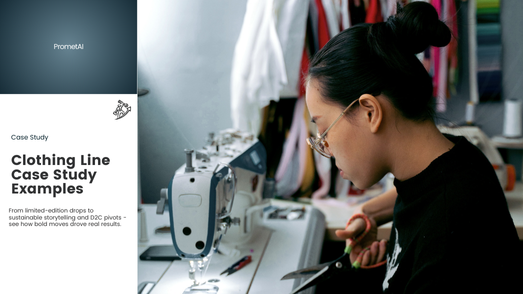See how innovative clothing brands grew faster with D2C pivots, sustainability, and limited-edition strategies that boosted sales and loyalty.
Case Study 1: How NovaWear Increased Online Sales by 62% with Limited-Edition Drops and Community Engagement
NovaWear is a fashion startup that has quickly made a name for itself in the streetwear clothing brand space. Based in Los Angeles, this direct-to-consumer clothing line was founded in 2019 with a sharp focus on limited-edition apparel that resonates with Gen Z fashion trends and the tastes of Millennials. By blending exclusivity with modern style, the brand has carved out a distinct identity in an increasingly saturated market.
About the Business
Name: NovaWear
Location: Los Angeles, California, USA
Type: Direct-to-consumer streetwear clothing line
Founded: 2019
Focus: Limited-edition apparel for Gen Z and Millennials
Website: novawear.de
For a young brand in the competitive online fashion market, success often comes quickly, but staying relevant is the true test. By 2021, NovaWear was confronting customer loyalty challenges in fashion that went deeper than sales numbers. Buyers saw the label as a one-time thrill rather than a brand worth returning to, undermining long-term growth potential.
The obstacles didn’t stop there. The company was grappling with sizing and returns issues in e-commerce, which were magnified by a wave of impulse buying in apparel. Customers, driven by excitement, often purchased pieces without careful consideration, leading to high return rates and eroding margins. Add to this the relentless flood of emerging labels fighting for attention, and NovaWear risked fading into the noise of an oversaturated market.
NovaWear understood that chasing growth through volume would only blur it into the sea of competing brands. Instead, the company chose to stand apart by doubling down on scarcity, authenticity, and community. This shift was not just tactical; it was philosophical. By embedding a limited-edition drops strategy and community-driven fashion marketing at the heart of its model, and amplifying them through TikTok fashion marketing and micro-influencer campaigns, NovaWear built a playbook of innovative business solutions tailored for a new generation of shoppers. Key actions included:
Limited-Edition Drops - NovaWear abandoned constant releases in favor of tightly controlled capsule collections every 6 - 8 weeks. Scarcity became the driver of demand. Countdown timers, teaser campaigns, and behind-the-scenes previews turned each launch into an event - one that customers didn’t just shop, but anticipated like a concert ticket drop.
Community Engagement - Recognizing that Gen Z values belonging as much as style, NovaWear built an inner circle through a private Instagram group. Here, its most loyal customers previewed upcoming designs, voted on product variations, and co-created with the brand. This community-driven fashion marketing approach shifted relationships from transactional to participatory, making customers feel like stakeholders rather than spectators.
Digital Marketing Overhaul - On TikTok and Instagram Reels, NovaWear moved beyond glossy ads. Behind-the-scenes videos, design stories, and micro-influencer partnerships delivered authenticity at scale. Relatable creators drove stronger engagement than expensive celebrity endorsements ever could.
Improved Customer Experience - Fit concerns were tackled head-on with detailed sizing guides and AR try-on tools via the mobile app. Returns became less of a liability through store credit incentives, which redirected refunds into repeat purchases rather than churn.
The Results (After 6 Months)
The strategy paid off. In just half a year, NovaWear transformed its trajectory. Online monthly sales leapt from $85,000 to $137,800an, an impressive 62% increase driven by heightened demand and viral community-driven campaigns.
Customer loyalty also took a dramatic turn. Return rates fell from 21% to 12%, thanks to improved sizing tools and AR features, while the share of repeat customers more than doubled to 41%. Engagement on social platforms exploded, surging from 2.4% to 7.9%, proving that micro-influencers and authentic short-form content could outperform traditional advertising in youth-driven markets.
Metric | Before | After | Change |
Online Monthly Sales | $85,000 | $137,800 | +62% |
Return Rate | 21% | 12% | –9 p.p. |
Repeat Customer Share | 18% | 41% | +23 p.p. |
Social Media Engagement Rate | 2.4% | 7.9% | +229% |

NovaWear’s experience highlights the strength of urgency and scarcity marketing combined with new generation influencer marketing. In an industry where trends evolve overnight, the brand demonstrated that brand growth strategies rooted in exclusivity, authenticity, and customer collaboration are more powerful than competing on scale.
Limited-edition drops generate urgency and amplify perceived value.
Involving customers in design decisions fosters deep loyalty and organic advocacy.
TikTok and micro-influencers deliver stronger results than traditional advertising in Gen Z fashion.
Flexible return policies can turn refunds into pathways for repeat business.
At its core, NovaWear demonstrated that brand growth strategies rooted in exclusivity, authenticity, and community can outpace even the fiercest competition. In doing so, the brand not only grew sales but also earned a place in the cultural conversation, a powerful reminder that in fashion, connection is the ultimate currency.
